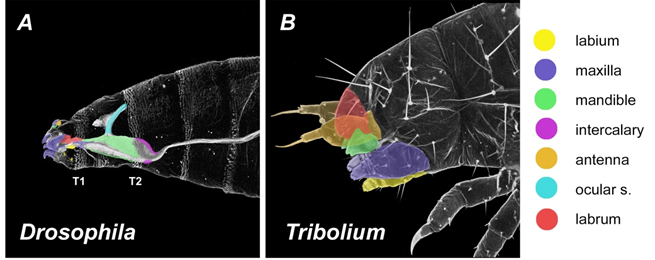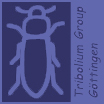In contrast to Drosophila, Tribolium develops a head with all structures that are typical for insects. With all the techniques available now, Tribolium has become the primary arthropod model system for arthropod head development.
One reason for our lack of understanding is the extremely derived head development of Drosophila: its involuted head comes to lie right within the thorax and the assignment of its derived structures to single segments is extremely difficult. This has hampered the recovery and interpretation of head genes in Drosophila.
 |
|
| The Drosophila larval head is derived in that all structures are turned outside into the thorax. The Tribolium head is insect typical. | |
It is clear, however, that the genetic cascade known from trunk segmentation does not account for more anterior pattern formation as pair-rule genes are only expressed posterior to the intercalary segment. We found that the Drosophila head-gap genes do not act in a similar way in Tribolium while Wnt signaling, Tc-six3 and Tc-foxq2 play important roles in anterior patterning. In that, Tribolium head patterning is more similar to the ground-pattern in animals than to Drosophila.
These genetic data provide additional arguments with respect to some long standing zoological questions like the segmental composition of the arthropod head and the nature of the labrum.
We have been using several complementary approaches to reveal the gene regulatory network. First, we are studying candidate genes known from Drosophila and vertebrate studies. Further, we are identifying novel head patterning genes by classical genetic screens and by our genome wide RNAi screen iBeetle. After gene identification, gene function and the regulatory interactions are studied by RNAi, transgenic misexpression and RNA-seq techniques. Further, we use confocal imaging and in vivo imaging to observe the cell and tissue movements during ontogenesis of the head. This has led to the establishment of the most comprehensive gene regulatory network of arthropod head development.
 |
|
| Our current understanding of the gene regulatory network of the anterior head (Kitzmann et al. 2017). | |

